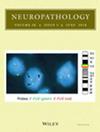一例以巨细胞形态为主的肌乳头状上皮瘤:罕见病例的全面基因组分析和文献综述
IF 1.3
4区 医学
Q4 CLINICAL NEUROLOGY
引用次数: 0
摘要
在综合组织学、分子学和解剖学背景的不断发展的脑外胶质瘤分类中,我们详细介绍了一例不同于常见组织病理学范围的罕见病例。我们介绍了一例 37 岁男子的病例,他的 L3-L4 水平有症状性脊髓压迫。神经放射学评估显示其为硬膜内包裹性肿块。组织学上,肿瘤显示出非典型特征:奇异的多形性巨细胞、核内包涵体、有丝分裂活动、大量嗜酸性细胞质和透明化血管,偏离了特征性的血管周围假乳头状或肌乳头状形态。免疫组化染色证实了这一差异,标记为胶质纤维酸性蛋白和上皮膜抗原阳性的肿瘤细胞具有特征性环状模式,CD99阳性,但Olig-2阴性。尽管组织学特征不典型,但这些标记物以及甲基化分析有助于将其归类为肌乳头状上皮瘤(MPE)。这一特征强调了多方面诊断过程的必要性,尤其是在组织学表现不常见的情况下,这也证实了免疫组化和分子诊断在形态学上模糊的上皮瘤分类中的关键作用,并体现了MPE的组织学多样性。本文章由计算机程序翻译,如有差异,请以英文原文为准。
A case of myxopapillary ependymoma with predominant giant cell morphology: A rare entity with comprehensive genomic profiling and review of literature
In the evolving landscape of ependymoma classification, which integrates histological, molecular, and anatomical context, we detail a rare case divergent from the usual histopathological spectrum. We present the case of a 37‐year‐old man with symptomatic spinal cord compression at the L3–L4 level. Neuroradiological evaluation revealed an intradural, encapsulated mass. Histologically, the tumor displayed atypical features: bizarre pleomorphic giant cells, intranuclear inclusions, mitotic activity, and a profusion of eosinophilic cytoplasm with hyalinized vessels, deviating from the characteristic perivascular pseudorosettes or myxopapillary patterns. Immunohistochemical staining bolstered this divergence, marking the tumor cells positive for glial fibrillary acidic protein and epithelial membrane antigen with a characteristic ring‐like pattern, and CD99 but negative for Olig‐2. These markers, alongside methylation profiling, facilitated its classification as a myxopapillary ependymoma (MPE), despite the atypical histologic features. This profile underscores the necessity of a multifaceted diagnostic process, especially when histological presentation is uncommon, confirming the critical role of immunohistochemistry and molecular diagnostics in classifying morphologically ambiguous ependymomas and exemplifying the histological diversity within MPEs.
求助全文
通过发布文献求助,成功后即可免费获取论文全文。
去求助
来源期刊

Neuropathology
医学-病理学
CiteScore
4.10
自引率
4.30%
发文量
105
审稿时长
6-12 weeks
期刊介绍:
Neuropathology is an international journal sponsored by the Japanese Society of Neuropathology and publishes peer-reviewed original papers dealing with all aspects of human and experimental neuropathology and related fields of research. The Journal aims to promote the international exchange of results and encourages authors from all countries to submit papers in the following categories: Original Articles, Case Reports, Short Communications, Occasional Reviews, Editorials and Letters to the Editor. All articles are peer-reviewed by at least two researchers expert in the field of the submitted paper.
 求助内容:
求助内容: 应助结果提醒方式:
应助结果提醒方式:


